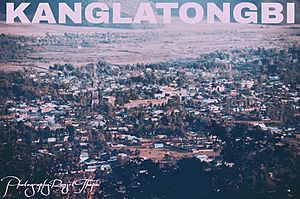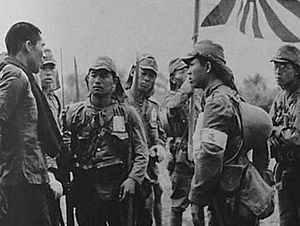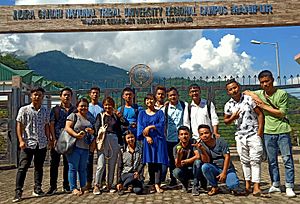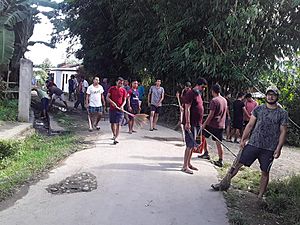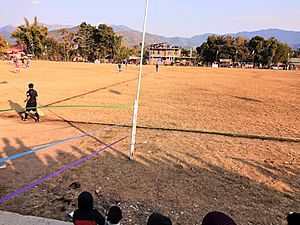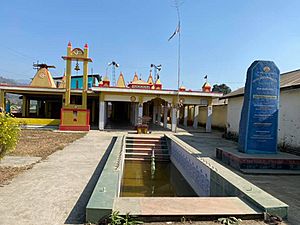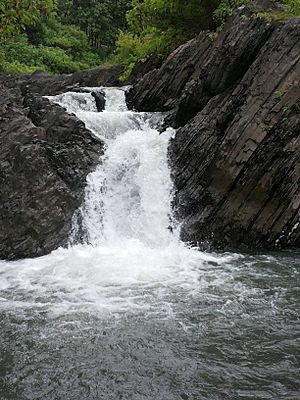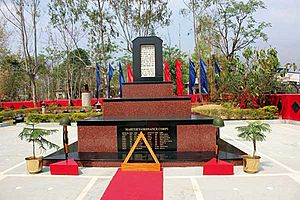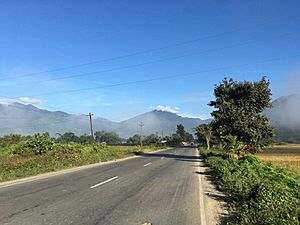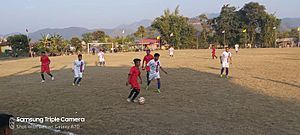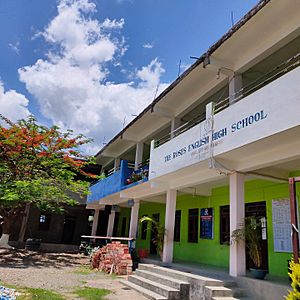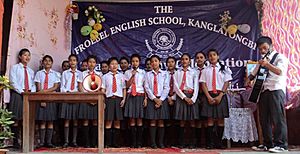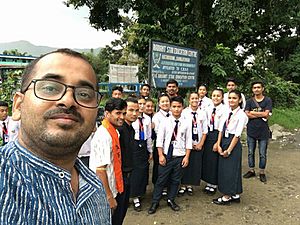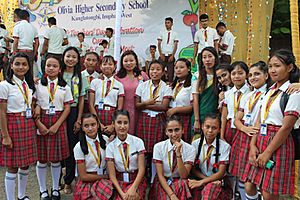Kanglatongbi facts for kids
Kanglatongbi is a lively village in the Imphal West district of Manipur, India. It's the most populated village in its district. You can find it in Lamshang Tehsil, and it's part of the Sekmai assembly and Inner Manipur Parliamentary area. The closest big city is Imphal, which is about 25 kilometers away.
Kanglatongbi is quite large, covering 1201.6 hectares. About 600 people live in every square kilometer. In 2011, the village had a total population of 7,152 people, with more females (3,719) than males (3,433). About 12.54% of the population were children under six years old. The village has a good average sex ratio of 1083 females for every 1000 males, which is higher than Manipur's state average. The child sex ratio is also higher than the state average.
Kanglatongbi is known for its high literacy rate. In 2011, about 87.77% of people could read and write, which is much higher than Manipur's state average of 76.94%. Male literacy was 94.33%, and female literacy was 81.78%. This village is growing fast in the Lamshang area. The weather in Kanglatongbi is usually warm, with an average high of 24.3°C (75.7°F). January is the coldest month, with an average low of 6.3°C (43.4°F).
Contents
Quick Facts About Kanglatongbi
| Nation | India |
| State | Manipur |
| District | Imphal West |
| Tehsil | Lamshang |
| Elevation | 2598 feet (792 meters) |
| Population (2011) | 7152 people |
| Languages Spoken | Nepali, Hindi, Meeteilon, Kuki, Naga, and English |
| PIN Code | 795136 |
| Vehicle Code | MN-01 |
History of Kanglatongbi
Kanglatongbi is famous for being the site of one of the toughest battles during World War II. This battle happened between April 6 and 7, 1944. Japanese troops were trying to capture Imphal and the areas around it. But the brave soldiers of the 221 Advance Ordnance Depot (AOD) fought back fiercely.
The Battle of Kanglatongbi: "Normandy of the East"
This battle is sometimes called the "Normandy of the East." In 1942, the Japanese Army had taken over Burma (now Myanmar). They used Burma as a base to attack Imphal and Assam in India. Their goal was to stop Chinese air forces from flying over the Himalayas.
At Kanglatongbi, the 221 AOD corps had set up defenses. Their position wasn't easy to defend, as they were open to attack from all sides. They had to rely on their courage to protect themselves.
After losing in Burma, the British army had moved back to Imphal in India because it was the quickest way. The British made their military setup stronger in Imphal. They formed the 23rd Indian Division in Manipur and built new airfields. They also got more soldiers and air force units.
The Japanese forces attacked Manipur in the spring of 1944. They bombed Imphal and cut off part of the main road between Imphal and Dimapur. They kept attacking Imphal for more than three months. But the Commonwealth Forces' 14th Army fought very hard and caused many problems for the Japanese.
The attack on Imphal ended in the summer of 1944. The tough battle finally finished on June 22, 1944, when British and Indian soldiers from Kohima and Imphal met at Milestone 109. The Japanese army suffered huge losses, with almost 50,000 soldiers losing their lives. It's believed that around 65,000 Japanese soldiers died in Kohima and Imphal during World War II. The British lost 17,000 soldiers, and the Allies had 12,603 losses.
The Battle of Kanglatongbi was a big part of the Battle of Imphal. It forced the Japanese to retreat after losing thousands of their soldiers. This battle is seen as one of the biggest defeats in Japanese history. Many Japanese soldiers died from hunger, sickness, and tiredness during their retreat. It's considered one of the most important battles of World War II, leading to the Japanese forces pulling back.
Geography of Kanglatongbi
Kanglatongbi is located in the far eastern part of India. It sits about 2600 feet (792 meters) above sea level. The weather here is humid subtropical. This means it has dry, cool winters and moderately hot monsoon seasons. In summer, temperatures average around 24 to 26°C. In winter, they can drop to about 6.3°C (43.4°F). January is the coldest month. The village gets about 1,290 millimeters (51 inches) of rain each year, with June being the wettest month.
Two rivers surround Kanglatongbi. The Kanglatongbi River is to the east, near the Indira Gandhi National Tribal University. The Sekmai River is to the west of the village. Imphal city is to the north, connected by National Highway 2. The Kanglatongbi War Memorial is to the south.
Government and How It Works
Kanglatongbi follows the local government rules set by the Imphal Municipal Corporation. The main office is in Lamphelpat, Imphal, and the sub-division is in Lamshang. The village has a special local council called the Gram Panchayat, which acts like the village's government.
Kanglatongbi is divided into six smaller areas called wards. Each ward has its own elected member. These ward members are chosen by the villagers. The Panchayat is led by a president and vice-president, known as the Pradhan and Oopa-Pradhan. These elected leaders serve for five years. Every five years, the village holds an election, and villagers over 21 years old can vote.
The village strongly supports women's rights. One-third of the seats in the local government are saved for women candidates. Seats are also reserved for people from scheduled castes and tribes.
People of Kanglatongbi
Before the 2021 Census, Kanglatongbi had a total population of 7,152 people. About 52% of them are female, and 48% are male. Most people belong to the general caste, while 8% are from Scheduled castes and tribes. About 13% of the village's population are children under 10 years old. There are about 1,600 houses in Kanglatongbi.
Population Growth
The number of people living in Kanglatongbi grew a lot between 2001 and 2011, by 65.3%. This suggests there might be a big increase in the 2021 census too. According to the earlier census, there were 1083 females for every 1000 males in the village. The sex ratio for scheduled castes was 1375, which is higher than for scheduled tribes (1079) and the general caste (1115). However, the number of girls compared to boys (child sex ratio) has gone down by 21 girls for every 1000 boys.
Village Wards
Kanglatongbi village has six wards:
- Shantipur
- Assam Rifles (AR) Colony
- Hati-Khuwa
- Tispari
- Vijayanagar
- Mandir
Each ward is led by its ward member. These members work closely with the Pradhan and Oopa-Pradhan. Their job is to help with the village's well-being, development, and safety. They also help solve problems and keep peace in the village.
Besides the Panchayat system, there's also a "women society." This group is run by the women of the village. They work to prevent and stop any kind of violence in the community.
There are also several youth unions. These are groups of young people who help their community. They encourage education, sports, and public safety.
Languages, Communities, and Religions
Most people in Kanglatongbi are Indian Gorkhas (also called Gurkhas). They speak Nepali, Hindi, Manipuri, and other local languages. About one-third of the population also speaks Nagamese, Kuki, Bhojpuri, and English.
The main religions are Hinduism and Christianity. About 50% of the people are Hindus, and 40% are Christians. The remaining 10% follow other religions. Kanglatongbi is a very diverse community. People from different backgrounds, religions, and languages live together peacefully. They share common interests and work for the good of the village.
Jobs and Buildings
Most people in Kanglatongbi earn money through farming. Many villagers are farmers, small business owners, or teachers. A lot of young people are also joining the Indian armed forces. About a quarter of the population serves in the Indian Army and other forces.
Most women in Kanglatongbi are homemakers, teachers, or run small shops. Only a small percentage of women work in government jobs. Thanks to a program called the Mahatma Gandhi National Rural Employment Guarantee Act, 2005, many men and women are now helping to improve the village's buildings and roads.
Kanglatongbi has one main public market called Kanglatongbi Bazaar Board. There's another market nearby, Sekmai Bazaar, which is outside the village's direct area.
Banks and Post Offices
Kanglatongbi has one bank, Punjab National Bank. There's also a State Bank of India ATM close to Kanglatongbi Mandir. The village has one main post office, located near the Kanglatongbi Mandir. Its postal code (PIN) is 795136.
Football Ground
The village has a football ground at Hindi High School, near Vijayanagar. This ground is used for many local and division tournaments. Locals also call it 'Roses ground' because it's close to Roses English High School. This same ground is also used for other events like music concerts, social gatherings, and meetings.
Temples and Churches
Kanglatongbi has many temples and a few churches. Most residents follow Hinduism, but people from different religions live together peacefully. The villagers are known for their unity and respect for everyone.
Each ward has its main temples where big festivals like Durga Puja, Diwali, Makar Sankranti, and Krishna Janmashtami are celebrated.
| WARD NAME | TEMPLE |
| Shantipur | Durga Mandir, Shantipur |
| Vijayanagar | Shree-Shree Vishnu Durga Shiva Panchayan |
| Tispari | Durga Mandir, Tispari |
| Mandir | Shree-Shree Vishnu Durga Shiva Panchayan |
| AR Colony | Durga Temple, Colony |
| Hati Khuwa | Hati-Khuwa Mandir |
| Seventh-Day Adventist Church | Bazaar Board |
| Hatikhuwa Gorkha Baptist Church | HatiKhuwa |
| Tangkhul Baptist Church | Tispari |
| Namdilong Baptist Church | Namdilong |
| Prakash Sunchuri Church | Bazar Board |
Places to Visit
- Kanglatongbi River and Dam: Locals call this "Dang-Dunge Khola." It's a popular spot for visitors. You can see waterfalls and beautiful scenery surrounded by the Koubru mountains. It has many trees, clean water, and natural plants. The cool weather makes it a great place for picnics, family gatherings, and adventures.
- Kanglatongbi War Memorial Cemetery: This place was built to honor the brave soldiers of the 221 Advance Ordnance Depot. They gave their lives during the Battle of Kanglatongbi on April 6 and 7, 1944.
Getting Around
By Air
The closest airport is Tulihal International Airport, about 30 kilometers away. It has direct flights to cities like Guwahati, Kolkata, and New Delhi.
By Road
Kanglatongbi is connected by National Highway 2, also known as the Imphal-Dimapur road. You can travel from Kanglatongbi to Imphal using private and public buses, auto-rickshaws, and mini-van services.
By Rail
Manipur is getting a new railway line called the Jiribam-Silchar railway, which will connect it to other states. This railway line is expected to be finished by 2022. Once it's ready, the distance from Kanglatongbi to the Imphal railway station will be about 28 kilometers.
Sports in Kanglatongbi
The main sports area is the Hindi High School Football Ground. This is a natural grass field mostly used for football tournaments. It's currently being improved.
The most important tournament held here is the "Khasi Tournament." This local tournament is organized every year by each village ward before the Durga Pooja festival. Six to ten teams participate, divided into Team A and Team B. Only local players representing their village can join.
In the past, the winning team was awarded a "khasi," which is a Nepali word for a male goat. This was related to a tradition during the Durga Pooja festival. However, to respect animal welfare, the village elders have stopped this practice. Now, the champion team receives trophies and cash prizes. The tournament is still called "Khasi Tournament" because the name is very popular, and most villagers like it.
Another big tournament is the All-Manipur Gorkha Football Tournament, held every year in Manipur. Only Gorkha players are allowed to participate in this special tournament.
Cricket is also very popular in Kanglatongbi. Many local and inter-village cricket tournaments happen every month. The villagers understand how important sports are. Their love for games shows how rich and friendly their community is.
Education in Kanglatongbi
Kanglatongbi has a very high literacy rate, which means many people can read and write, even more than the average for Manipur state. This is because the villagers understand how important education is today. Many good schools in the village produce bright students and scholars.
There are several high schools in the village. Most of them are private schools. There is one government-funded high school called Hindi High School, located in Vijayanagar. This school has helped many students go on to serve in the Indian Army.
Many private high schools and higher secondary schools are connected to the Council of Higher Secondary Education (COHSEM) Manipur and the Central Board of Secondary Education (CBSE) India.
Some of the well-known and top-performing schools are:
- Roses English High School
- The Froebel English School
- Radiant Star Education Center
- Olivia Higher Secondary School
- Chil-Chil Asian Mission English School
There is also a non-profit group for students called the All-Manipur Gorkha Students Union. This group is run by the Gorkhas of Manipur. They work to support students from all backgrounds with their education and any social challenges they face.
Healthcare in Kanglatongbi
The main hospital that serves the villagers of Kanglatongbi is the Regional Institute of Medical Sciences (RIMS) in Imphal. It is about 26 kilometers away from the village. Another important healthcare service is the Sekmai Primary Health Care, which is 5 kilometers from the main village. Kanglatongbi also has many private clinics and local drugstores.


